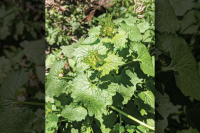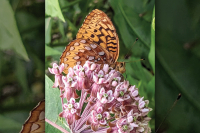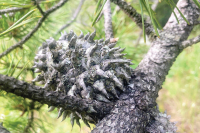The Joyful Botanist: Something Spicy
Many of the first signs of springtime are subtle. There are little shifts in the breeze as the sun begins to feel a bit warmer and remains in the sky a little bit longer each day. Birdsong increases morning and evening, and other flying beings begin buzzing around looking to forage some pollen and nectar.
Up Moses Creek: Walking the log
I’d no sooner opened my book of Robert Frost’s poetry to start the morning right when Neighbor J drove up. A wind had downed trees in his pasture, and he was sawing one up when his chainsaw had gotten pinched — “Can you help me get it out?” A “pinch” happens when the tree trunk suddenly sags or shifts, clamping the saw bar tight in the kerf like gigantic wooden jaws.
Notes from a plant nerd: In the pines
In the Cherokee cosmology, evergreen trees were given their ability to hold onto their leaves all winter as a reward for s taying up all night long for seven days, keeping the sacred fire lit.
In a lurch about larch: Mystery tree leaves retired professor probing for answers
 To the untrained eye, the tree looks like just another evergreen, just another species thrown into the mix of natural diversity along the Blue Ridge Parkway. But the American larch tree growing opposite the pull-off for Courthouse Valley Overlook fails on both counts: though it’s in the pine family, it is not an evergreen, and it is not a native.
To the untrained eye, the tree looks like just another evergreen, just another species thrown into the mix of natural diversity along the Blue Ridge Parkway. But the American larch tree growing opposite the pull-off for Courthouse Valley Overlook fails on both counts: though it’s in the pine family, it is not an evergreen, and it is not a native.
“This just blew me out of the water a little bit,” said Dan Pittillo, the retired Western Carolina University botany professor who found the tree. “I didn’t expect it.”
Safety, maintenance headaches put an end to student hang out spot
 A row of four stately evergreens that anchored the front of Waynesville Middle School — providing both shade and a meeting hub on campus — were cut down two weeks ago to the chagrin of students and teachers.
A row of four stately evergreens that anchored the front of Waynesville Middle School — providing both shade and a meeting hub on campus — were cut down two weeks ago to the chagrin of students and teachers.
Rallying around a historic tree
Against all odds, a 250-year-old scarlet oak tree still stands on N.C. 110 south of Canton, despite being struck by lightning, despite neighboring a busy road, despite being forgotten by many for more than three decades.
A Native American council existed near the Osborne Boundary Oak, and Gen. Griffith Rutherford and his men marched by the tree while battling Native Americans nearby. The tree is documented to have served as a line marker in the late 1700s.
It remained in public memory long after.
In 1976, hundreds of local activists rallied to save the oak after the North Carolina Department of Transportation announced it would fell the tree in its quest to widen N.C. 110. Public opposition was so strong that DOT moved the highway to rescue the tree in 1978. It even put up a guardrail to protect the historic oak.
After so much energy was invested into preserving the Osborne Boundary Oak, it now lives unrecognized and undistinguished, trimmed and hacked haphazardly like any other tree by the DOT.
This year, Doris Hammett, one of the original protesters against the DOT in the ‘70s, decided it was time to take up the cause once again.
Hammett’s husband spent his last days near the tree at Silver Bluff Village, an assisted living facility in Canton. She visited him daily and would pass the diseased tree each time she went. Hammett knew she had to take action.
“In the ‘70s, the tree had a full canopy of leaves ... It was a healthy tree,” Hammett said. “When I went back, the tree has rotten limbs, it’s diseased, it’s been hacked.”
Hammett contacted the DOT, the Haywood County manager, a state senator, two historical societies, Haywood Community College’s Forestry Department — everyone she could think of who might help.
The DOT was caught completely off-guard by Hammett’s call. Changing of the guard at the agency meant knowledge of the oak had gradually been lost as officials retired.
Lloyd Anderson of Southern Tree Care, along with Doris, her daughter, DOT representatives, and historical society members, recently visited the oak to see if any hope remained for the badly damaged tree.
After a close inspection, Anderson said the tree had suffered significant root loss due to road construction, been injured by salt flying off the highway in the wintertime, and had survived being struck by lightning in the last five years.
Despite all that, Anderson concluded that with proper care, the tree could be rehabilitated and survive for another 50 years.
“It’s a tough, old tree,” Anderson said. “Everything that’s been done to it, especially after it’s been struck by lightning, it definitely has a vigor and life to it.”
Richard Queen, roadside environmental engineer at the DOT, said since learning of the oak and seeing it face-to-face, he, too, would like to see the tree saved.
Queen said the DOT would take care of the tree and bring it back to life, though the agency’s first concern will always be public safety.
“We always have to consider the liabilities of a limb falling on someone as they drive by,” Queen said.
Hammet is confident the DOT will once again take action to save the tree, but regardless of the help it has pledged, Hammett is not taking any chances on the tree this time around. She hopes to raise awareness of the Osborne Oak and other historic trees in the area to ensure they are remembered and flourish for as long as possible.
The Bethel Rural Organization is working to get the Osborne Boundary Oak on the America’s Historic Tree Register, while Hammett has convinced Haywood Community College to have its students study the tree each year to observe its growth.
With Arbor Day coming up April 30, Hammett and her daughter, Karen, hope the community will not only plant new trees but also recognize the special trees we already have.
“We have very little of the old growth forest left,” said Karen Hammett. “Old remaining giants show us what the forest was originally like before settlers came here.”
Recognized ‘Tree Cities’ in WNC
Waynesville, Sylva, Asheville and Brevard were recognized by the nonprofit Arbor Day Foundation as a Tree City USA community for their commitment to urban forestry.
Waynesville was one of only 20 towns in the state to also receive a Tree City USA Growth Award for demonstrating progress in its community forestry program recycling. The prestigious Growth Award honors environmental improvement and higher levels of tree care in Tree City USA communities.
Tree City USA communities must have a tree board or department, a tree care ordinance, a comprehensive community forestry program, and an Arbor Day observance and proclamation.
More information about Tree City USA can be found at www.arborday.org/TreeCityUSA.
Not every tree planting is beneficial
Planting a tree this Arbor Day, April 30? Waynesville town horticulturist Jonathan Yates hopes it’ll be the “right tree for the right place.”
Yates bemoans that many trees in town are mutilated each year to keep from touching utility lines overhead. He would rather see the trees cut down and have shorter trees planted, which would save homeowners from investing money in yearly maintenance, Yates said.
Waynesville has a list of trees that are appropriate for each neighborhood. Contact Yates at 828.456.3507 for more information.









